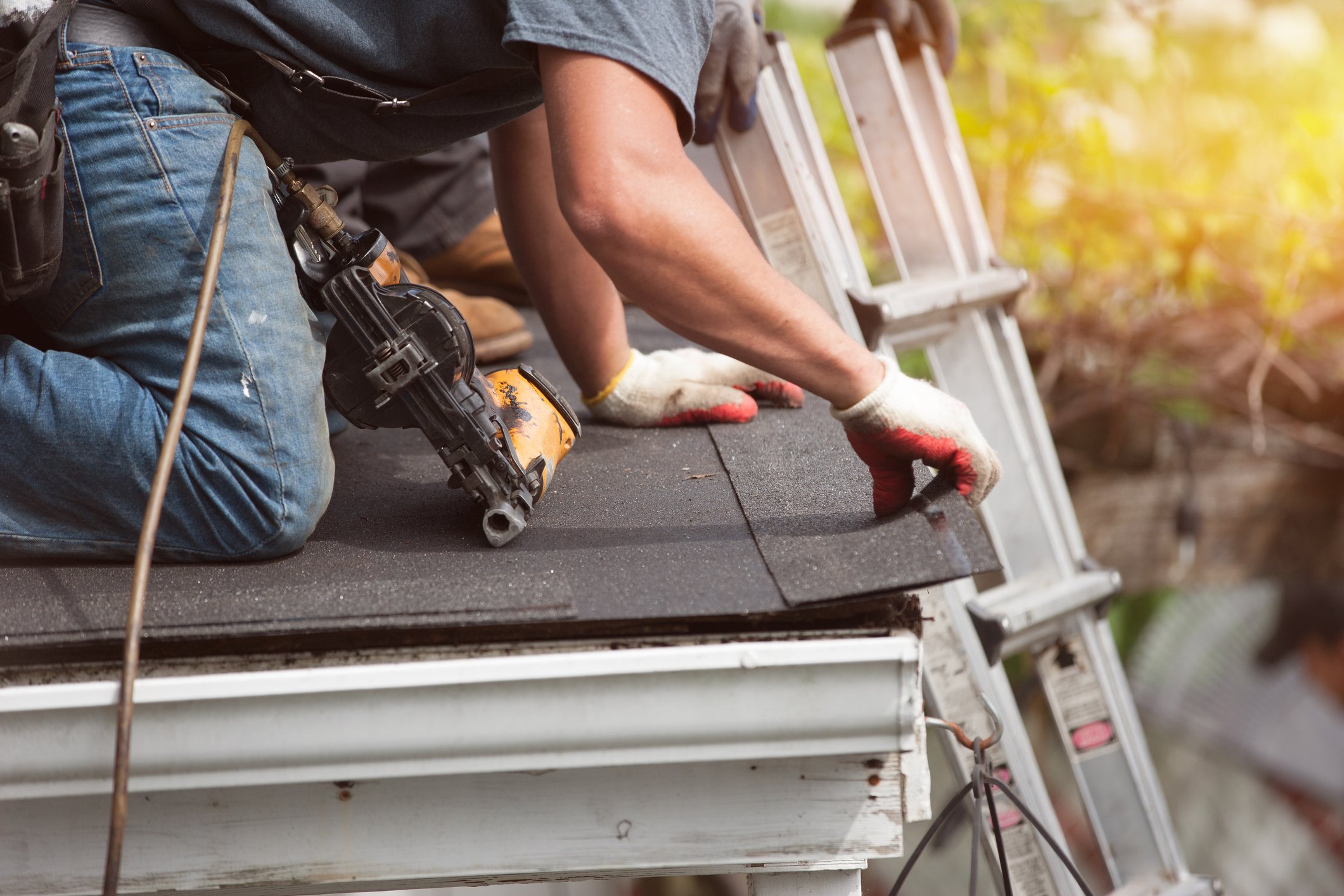While roof replacement costs can be high, you might find that it’s a worthwhile investment once you factor in the benefits.
A new roof can protect your home from the elements, reduce energy use by better insulating your home and potentially increase its resale value.
What does it cost to replace a roof?
| Type of Roof | Typical replacement cost |
|---|---|
| Asphalt shingle | $4 to $7 per square foot |
| Metal roof | $7 to $30 per square foot |
| Slate tile | $23 to $38 per square foot |
Price ranges reflect averages sourced from sites like Fortress Roofing[1], Elite Roofing Halifax[2], Reno Assistance[3], HomeStars[4] and Reddit[5]. Your actual roofing costs may vary.
Let’s say your home has a 3,000 square foot roof. Using these estimated ranges, your total costs might look like:
- Asphalt roof: $12,000 – $21,000
- Metal roof: $21,000 – $90,000
- Slate tile roof: $69,000 – $114,000
Factors that affect the cost of roof replacement
When preparing for a roof replacement, it’s always advantageous to shop around. Make sure you’re considering the following factors:
Roofing materials
The type of roof has a major impact on your overall costs. Be sure to talk to professional roof installers about what makes sense for your area and what they recommend.
- Asphalt shingle. The cheapest and most popular roofing material in Canada is asphalt shingle. These shingles come in different colours and can last around 15 to 30 years.
- Metal. A metal roof costs more than a shingle one but is more durable and can last for around 40 to 70 years. That said, hail and fallen branches can cause dents in aluminum or standing seam panels. You could opt for steel to prevent damage, but it will add even more to the cost.
- Slate tiles. Slate roofing is expensive to install and may require additional structural reinforcement due to its weight. The tiles can last 75 years or more and give a Mediterranean or European look to your roof.
- Wood shake. Wood shakes, not to be confused with wooden shingles, are often made from cedar. They can give your home a unique look and typically last 30 to 50 years. However, they can be damaged by mould and mildew. Areas prone to wildfires may have specific rules about wood shake roofing, so check with your municipality before pursuing this option.
Roof size
The bigger your roof, the more you’ll need to spend to cover it in roofing material. Depending on the age and condition of your current roof, you may not need to do a full roof replacement. You may also be able to get by with a process known as re-roofing or re-shingling, in which new shingles are installed over the old ones.
Pitch and complexity
The slope and shape of a roof can also have a major impact on the cost of replacement. If you have a particularly steep roof, it’ll be more difficult for contractors to replace than a flat one would be. Additionally, if your roof has multiple layers or is complicated to access, it may require more hours of labour and make the job more expensive.
Location
In cities with a high cost of living, a roof replacement will typically cost moreIn some rural areas, costs could increase since if ittakes more effort to get workers and supplies out to the property.
Other roofing costs to consider
When getting a quote from roof installers, request an itemized breakdown. While the quote will focus on the overall cost to replace your roof, you’ll also want to keep an eye out for these additional costs.
Removal and disposal of current roofing materials
The cost to remove and dispose of your current roofing materials is usually included in the quote.
If you have access to a truck and disposal site and would like to handle this part yourself, you could ask for a discount. However, many municipalities charge disposal fees, which can cut into how much you save with your discount. Gutters and downspouts
If your roof is several decades old, it may also be time to install new gutters and downspouts on the house. Upgrading these components at the same time may allow for an easier gutter installation process and ensure that water continues to flow away from your home properly.
Rafters and trusses
Your roof replacement contractor should inspect all aspects of your roof, including the rafters and trusses. If they notice mould or rotting wood, they may recommend replacing the rafters and trusses. This is a huge job and would only be recommended if there are significant concerns about damage to the home. If you go this route, you may need to consult a structural engineer and apply for building permits.
Benefits of installing a new roof
Compared to a kitchen, bathroom or other renovations, a new roof may not seem like it provides many benefits for homeowners aside from getting rid of the old roof damage. However, replacing your roof can actually come with some important perks.
Reduced home insurance premiums
With a new roof, there’s less risk of leaks and other damage. Some roofing materials are more durable and fire-resistant than others, which can be relevant to home insurance providers when calculating risk. You should call your home insurance provider as soon as you install a new roof, as your premiums could go down.
Better protection from water damage
A roof’s main job is to keep your home dry. A damaged roof could leak and cause major water damage. Mould could grow in your attic or inside your walls, and, if enough water seeps into your home, it could rot your rafters or trusses, creating a much bigger structural issue.
Energy efficiency
Your roof acts as the last line of defence in keeping rising warm air inside your home. Older roofs allow more heat to escape, leading to colder houses and higher utility bills. A new roof could make your home more energy efficient. If you add insulation at the same time, you may qualify for government incentives, tax credits or grants, such as the Greener Homes Grant.
Potential increase in home value
If you decide to sell your home, a new roof could potentially increase its value. House hunters will naturally compare your property to others on the market and will likely get an home inspection of all its systems. If your home has a new roof while others don’t, it may be more appealing to prospective buyers, since it’s one less repair that they’ll need to deal with in the future.
Frequently asked questions about roof replacement costs
The lifespan of a new roof depends on the materials used and local conditions. Asphalt shingle roofs can typically last up to 30 years, whereas wood shake roofs can typically last up to 50. Metal roofs can last even longer at up to around 70 years, while slate tile roofs can typically last well over 100 years.
Generally, asphalt shingle roofing is the cheapest material available for a new roof. However, the cost of a new roof also depends on other considerations, including your roof size and pitch, and the complexity of the installation process.
Article Sources
-
Fortress Roofing, “Cost of Roof Replacement Canada,” accessed July 23, 2024.
-
Elite Roofing Halifax, “Metal Roofing Cost Canada,” accessed July 23, 2024.
-
Reno Assistance, “Roof Replacement Cost,” accessed July 23, 2024.
-
Home Stars, “Guide to Roofing Costs and Estimates in Canada,” accessed July 23, 2024.
-
Reddit, “Reasonable roofing cost per square,” accessed July 23, 2024.
DIVE EVEN DEEPER

Home Improvement Project? 5 Questions to Ask Before You DIY
Before deciding that you’ll DIY, consider the time, expertise and costs involved to complete your project — and how you’ll pay for it.

Should You Use a Personal Loan for Home Improvements?
Personal loans are funded quickly and feature lower interest rates than credit cards, but may be too restrictive for major home improvement projects.

HELOC: What It Is and How It Works
A home equity line of credit, or HELOC, allows you to borrow money using your home equity as collateral. HELOC’s are variable rate loans with interest-only payments.

Kitchen Renovation Cost in Canada: Plan Your Budget
You can expect to pay anywhere from about $13,000 to over $40,000, depending on things like square footage and materials.


